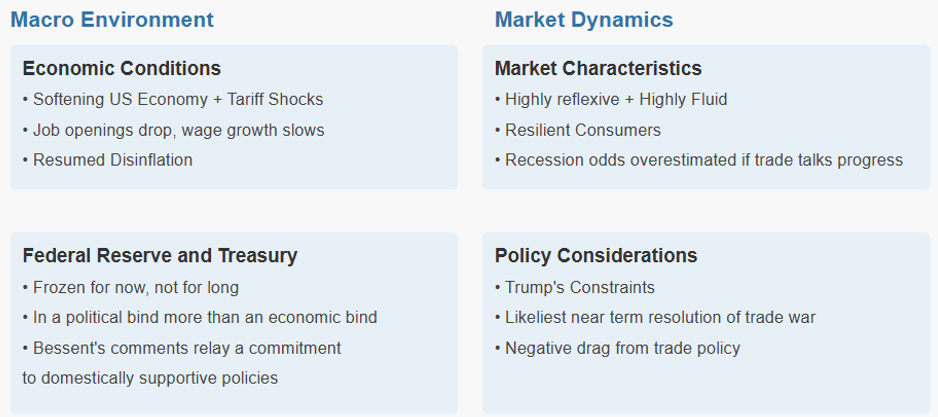
<aside> 💥
Citrini的宏观文章我觉得写得蛮好的,感兴趣的可以仔细看一下全文。
Thesis
citrini是目前看到对市场叙事和节奏把握最准确的分析师,他过往的portfolio是极低回撤跑赢SPX, 可以给他的观点加高权重。
</aside>



How should we think about “macro” in this current environment?在当前环境下,我们应如何看待“宏观”?

When we wrote “Global Macro Trading for Idiots: Part 4” in July 2024, we commented that the traditional macroeconomic indicators of a recession within the next year (the Sahm Rule, the Fed’s yield-curve based model and inversion of the yield curve, etc.) all meant that *if we were going to have a recession, it was going to come in the next 12 months.*当我们在 2024 年 7 月撰写《全球宏观交易入门:第四部分》时,我们评论说,传统的宏观经济衰退指标(萨姆规则、美联储基于收益率曲线的模型及收益率曲线倒挂等)都表明,如果我们将迎来衰退,那将在未来 12 个月内发生。
We’re nearing the end of that window, but we’re hardly out of the woods given the policy curveballs that have been thrown into the mix. Still, outside of the downward pressures created by the tariffs, the US economy continues a trend of further cooling labor market and further disinflation.我们正接近这一时间窗口的末尾,但鉴于政策上的变数,我们仍未完全脱离困境。尽管如此,除关税带来的下行压力外,美国经济仍呈现劳动力市场进一步降温和通胀进一步缓解的趋势。
While tariffs create enormous bimodal uncertainty, could there be sufficient resiliency in the US economy to withstand tariff shocks long enough to get through to the other side? Could a sudden reversal of trade policies also reverse gloomy growth expectations as the Fed’s jumbo cut in 2024 Sep did?虽然关税带来了巨大的双峰不确定性,但美国经济是否具备足够的韧性来承受关税冲击,足够长时间渡过难关?贸易政策的突然逆转是否也能像美联储 2024 年 9 月的大幅降息那样,扭转悲观的增长预期?
We lean towards the view that recession risks are at present overstated, based on the current macro and micro data. While some level of economic slowdown is almost guaranteed, certain corners of the markets may have priced in even more.基于当前的宏观和微观数据,我们倾向于认为目前对经济衰退风险的评估被高估了。虽然某种程度的经济放缓几乎是必然的,但市场的某些领域可能已经定价了更严重的情况。
However, there is a large disparity between the pricing of a recession in areas like bonds (especially the front end of the curve) and oil vs. equities. On equities broadly, we see a sideways trend emerging for indices that will be marked by rapid overreactions in both directions and extreme dispersion.然而,在债券(尤其是曲线前端)和石油等领域对衰退的定价与股票市场之间存在巨大差异。就股票市场整体而言,我们看到指数呈现横盘趋势,伴随着双向的快速过度反应和极端的分散性。
The enormous uncertainty of tariffs ultimately stems from a geopolitical realignment shock that is at least in the short term determined in the mind of a man and a tweet. In his book “Geopolitical Alpha”, Marko Papic says that predictions are better made from the perspective of “constraints” rather than “preferences”.关税带来的巨大不确定性最终源于地缘政治重组冲击,而这种冲击至少在短期内是由一个人的思维和一条推文决定的。在他的著作《地缘政治阿尔法》中,Marko Papic 表示,预测更应从“约束”而非“偏好”的角度出发。
We all know what President Trump’s preferences are, but what are his constraints? We would lay them down as the following three categories:我们都知道特朗普总统的偏好,但他的限制是什么?我们将其归纳为以下三类: